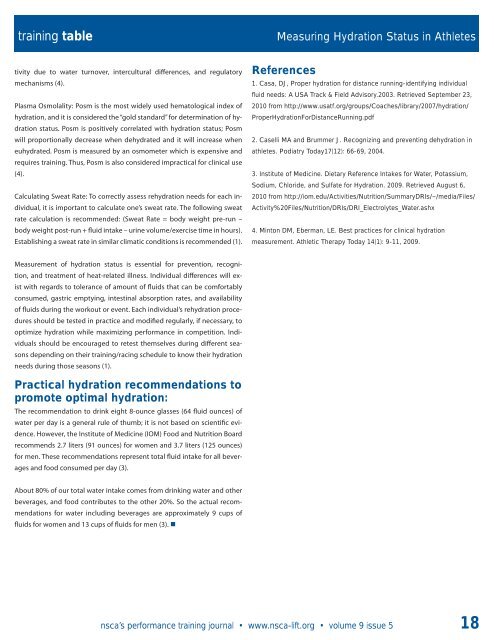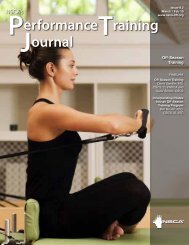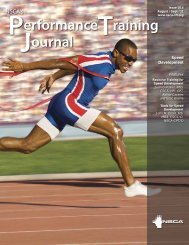PTJ Sep Oct 2010.pdf
PTJ Sep Oct 2010.pdf
PTJ Sep Oct 2010.pdf
You also want an ePaper? Increase the reach of your titles
YUMPU automatically turns print PDFs into web optimized ePapers that Google loves.
training table<br />
Measuring Hydration Status in Athletes<br />
tivity due to water turnover, intercultural differences, and regulatory<br />
mechanisms (4).<br />
Plasma Osmolality: Posm is the most widely used hematological index of<br />
hydration, and it is considered the “gold standard” for determination of hydration<br />
status. Posm is positively correlated with hydration status; Posm<br />
will proportionally decrease when dehydrated and it will increase when<br />
euhydrated. Posm is measured by an osmometer which is expensive and<br />
requires training. Thus, Posm is also considered impractical for clinical use<br />
(4).<br />
Calculating Sweat Rate: To correctly assess rehydration needs for each individual,<br />
it is important to calculate one’s sweat rate. The following sweat<br />
rate calculation is recommended: (Sweat Rate = body weight pre-run –<br />
body weight post-run + fluid intake – urine volume/exercise time in hours).<br />
Establishing a sweat rate in similar climatic conditions is recommended (1).<br />
References<br />
1. Casa, DJ, Proper hydration for distance running-identifying individual<br />
fl uid needs: A USA Track & Field Advisory.2003. Retrieved <strong>Sep</strong>tember 23,<br />
2010 from http://www.usatf.org/groups/Coaches/library/2007/hydration/<br />
ProperHydrationForDistanceRunning.pdf<br />
2. Caselli MA and Brummer J. Recognizing and preventing dehydration in<br />
athletes. Podiatry Today17(12): 66-69, 2004.<br />
3. Institute of Medicine. Dietary Reference Intakes for Water, Potassium,<br />
Sodium, Chloride, and Sulfate for Hydration. 2009. Retrieved August 6,<br />
2010 from http://iom.edu/Activities/Nutrition/SummaryDRIs/~/media/Files/<br />
Activity%20Files/Nutrition/DRIs/DRI_Electrolytes_Water.ashx<br />
4. Minton DM, Eberman, LE. Best practices for clinical hydration<br />
measurement. Athletic Therapy Today 14(1): 9-11, 2009.<br />
Measurement of hydration status is essential for prevention, recognition,<br />
and treatment of heat-related illness. Individual differences will exist<br />
with regards to tolerance of amount of fluids that can be comfortably<br />
consumed, gastric emptying, intestinal absorption rates, and availability<br />
of fluids during the workout or event. Each individual’s rehydration procedures<br />
should be tested in practice and modified regularly, if necessary, to<br />
optimize hydration while maximizing performance in competition. Individuals<br />
should be encouraged to retest themselves during different seasons<br />
depending on their training/racing schedule to know their hydration<br />
needs during those seasons (1).<br />
Practical hydration recommendations to<br />
promote optimal hydration:<br />
The recommendation to drink eight 8-ounce glasses (64 fluid ounces) of<br />
water per day is a general rule of thumb; it is not based on scientific evidence.<br />
However, the Institute of Medicine (IOM) Food and Nutrition Board<br />
recommends 2.7 liters (91 ounces) for women and 3.7 liters (125 ounces)<br />
for men. These recommendations represent total fluid intake for all beverages<br />
and food consumed per day (3).<br />
About 80% of our total water intake comes from drinking water and other<br />
beverages, and food contributes to the other 20%. So the actual recommendations<br />
for water including beverages are approximately 9 cups of<br />
fluids for women and 13 cups of fluids for men (3). •<br />
nsca’s performance training journal • www.nsca-lift.org • volume 9 issue 5 18





